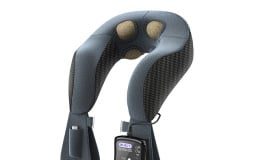Physical therapists often recommend the chin tuck to treat neck pain and align the spine.
This simple and effective exercise will not only relieve neck pain, but also improve the neck’s flexibility and strength.
What are the main causes of neck pain and stiffness?
Neck pain can be caused by several factors, including:
- Poor posture can cause muscle strain
- injuries
- Muscle stiffness
Neck pain can be a symptom of meningitis, a condition that causes inflammation around the spinal cord and the brain.
It can also be a sign of other conditions such as osteoporosis or arthritis.
Benefits of chin-tuck exercise
Chin tucks is a neck movement that involves the retraction of chin muscles.
This exercise improves neck flexibility, strengthens deep neck flexors and helps maintain a good posture. It is also great for the lower cervical extensors, and helps prevent slouching or Dowager’s Hump.
If neck pain is due to poor posture then the chin tuck can help strengthen the deep cervical flexors, as well as the lower cervical extensors. It also targets the front side of your neck. This will align the head above the spine. This exercise can also stretch the scalene muscle.
This exercise is also beneficial for improving posture, easing neck spasms, and relaxing neck muscles.
How to perform chin-tuck exercise?
The chin tuck can be done in a variety of positions, whether you are standing or sitting. Here are five different ways to perform the exercise.
#1 Sitting/standing
To do it:
- Stand with your feet together or sit straight on the floor. Slowly tilt your chin toward your chest.
- Keep your neck as straight and as long as possible when performing the movement. Slide your chin to the starting position.
- Do not force the neck muscles. Instead, move gently and hold for 5 seconds after each slide.
- Repeat the exercise several times.
Second lying down
To do it:
- Lay down on your back with your knees bent, and feet flat on floor. You can also place a soft cushion under your head to provide extra comfort and support.
- Continue to hold this position and begin to tuck in your chin. Slowly release your head back and repeat the exercise several times.
#3 Prone Head Lift
To do it:
- Lay on your stomach with the forehead on a pillow. Start to tuck in your chin and move it towards your upper chest area.
- Hold the position for several seconds and then repeat the exercise.
#4 Point kneel position
To do it:
- Position yourself on all fours, palms and knees facing the floor. Keep your eyes on the floor in between your hands.
- Relax your shoulders and move them back. Start to retract your neck and nod your head towards your upper chest.
- Hold the position for several seconds and repeat the movement several times.
#5 Against Resistance
You will need a high-quality resistance band for this variation.
To do it:
- Start by wrapping a band around your head.
- Grab the ends of the cord with both hands and make sure that they are just in front your head.
- You can gently pull the band with your hands while moving your chin from the resistance band.
- Slowly move your chin to your upper chest area and hold that position for a few moments.
- Repeat the exercise a few more times.
How to incorporate chin tucks into your daily routine?
It is recommended that you do chin tucks for at least 10 reps in 5 sets throughout the day to reap the benefits. This exercise can be done daily, but alternate days if you suffer from severe neck or back discomfort.
Regular chin tucks can help strengthen the neck, ease pain, and keep the posture upright. They also prevent muscle tightness and offer a relaxing stretch.

We understand how important it is to choose a chiropractor that is right for you. It is our belief that educating our patients is a very important part of the success we see in our offices.




